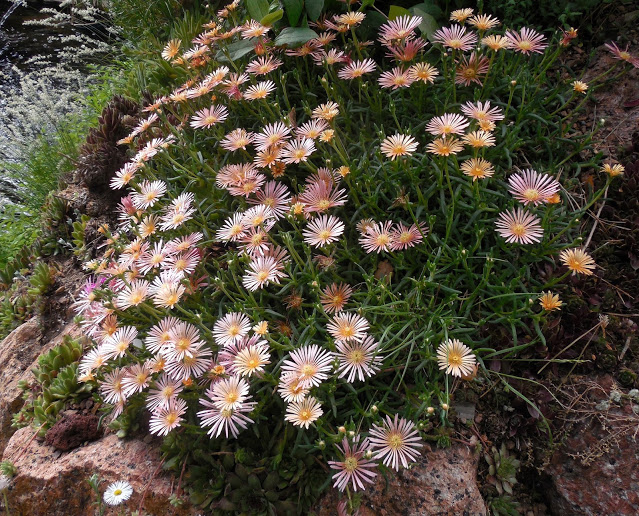The Only Truly Hardy Ice Plants are these!
By Panayoti Kelaidis, Director of Outreach & Senior Curator, Denver Botanic Gardens
When Plant Select began marketing new varieties of Delosperma late in the 1990s this genus was still a novelty in world Horticulture. The yellow (D. nubigenum) and purple (D. cooperi) hardy ice plants were being grown and sold by a few nurseries—but look up almost any book or catalog from the last Millennium—Delosperma is almost always missing!
For the first decade of this Millennium, Plant Select had a corner on the Delosperma market: STARBURST had been pirated by several major seed companies, but no one could replicate MESA VERDE’s subtle adobe color, and by the time FIRE SPINNER arrived with a bang (heralded by nurseries across the country) the race was on. Hybridizers in Peru, Germany, the Czech Republic, England, Japan, Netherlands, and beyond began daubing pollen on delospermas, hoping to come up with a winner like FIRE PINNER.
Some remarkable plants have suddenly appeared everywhere. The front runner has unquestionably been Koichiro Nishikawa, who produced the brilliant, diminutive “Jewels of the Desert” series, evocatively named after semi-precious stones like “Garnet” and “Topaz”. Unquestionably dazzling—but their small size and tenderness disappointed many buyers. He followed up with the much larger and likewise showy “Wheels of Wonder” in yellow, orange, white, and pink. These make outstanding displays in containers but are just as tender as the Jewels.
Other hybridizers in the United States have launched lines of similarly tender, and even less showy plants. Meanwhile Plant Select has introduced the spectacular GRANITA series hybridized by John Stireman and the glowing, blood-red RED MOUNTAIN FLAME created by David Salman.
What sets the ten Plant Select introductions apart from all others so far? The vetting process that these plants go through I believe is unique: rather than mass-producing some promising seedlings straight from the greenhouse, Plant Select introductions are tested at many sites for many years. I once did an analysis of Plant Select introductions: they AVERAGED 19 years from the time they were first identified until they were announced and marketed nationally! I can guarantee you this is not happening with “the competition!”
But there is another secret: the Plant Select plants all derive from higher altitude, more cold-hardy germplasm. FIRE SPINNER was collected on the summit of Sneeberg, one of the highest peaks of the East Cape mountains—which looks a lot like the Matterhorn. MESA VERDE and ALAN’S APRICOT
derive from plants that grew at 8,000 and 9,000’ altitude in nature.
But the best thing about each PLANT SELECT introduction is that these are true color breaks and unique in their habit and form. I characterize each of the ten ice plant introductions thus far as “sleepers”—plants that have not yet reached their potential in gardens.
The “Wheels of Wonder”, “Jewels of the Desert” have had fantastic and enviable marketing and distribution: I see these in Box Stores across America and Europe as well: although superb as annuals, I fear that many hopeful gardeners plant these and are disappointed when they don’t come back a second year as they expect from a “hardy ice plant”.
Planted side by side with Plant Select introductions, we have seen ice plants from every other introduction scheme melt away almost every winter when the Plant Select introductions sail through and perform spectacularly.
It’s true that even our plants may not be hardy everywhere: but given proper drainage, a sunny aspect, and sometimes a pane of glass for protection in wetter climates, every one of the Plant Select introductions has performed spectacularly in the Midwest, East Coast, and even in the rainy Pacific Northwest. They alas do NOT do well in Zone 9 or warmer areas: they need the winter cold.
The ONLY plants that deserve to be marketed as Hardy Ice Plants are the Plant Select introductions. I wish Garden Center, Nursery and Big Box Stores would put the OTHER ice plants in with the Annuals where they belong.
(Read more about ice plant and other fantastic plants on Panayoti’s blog! http://prairiebreak.blogspot.com/


